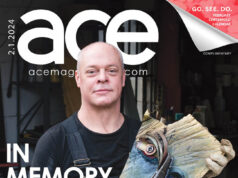Pickings are a bit slim amongst movies in wide release this week – those who aren’t particularly interested in the eighteenth-or-so Saw sequel are stuck with Clint Eastwood’s disastrous *Hereafter* or some snooty highbrow film that premiered at the Museum of Modern Art in New York (Jackass 3D). Luckily, Lexington has a wide variety of alternative options to satisfy local movie-goers.
On October 28th, the latest from the hardest working men in film meta-comedy will be screening at the Fayette Mall Cinemark. After the cancellation of their classic TV series “Mystery Science Theater 3000,” which featured comedians mercilessly heckling cheapo B-movie trash, comedians Michael J. Nelson, Kevin Murphy, and Bill Corbett set their sights higher and started targeting upscale A-movie trash. Their site Rifftrax now sells downloadable commentaries that skewer everything from Titanic to Twilight. It’s completely uproarious, but it’s also a uniquely thorough form of criticism – the group pores over these films frame-by-frame to analyze what does and doesn’t work in a film, which then allows them to construct the most insightful possible cheap shot of Robert Pattinson. The crew is now heading back to their roots, taking apart 1959’s schlocky House on Haunted Hill in a live broadcast. Corny lines will be mocked, hammy performances will be ridiculed, and cheesy special-effects will be eviscerated, but please – leave the peanut gallery work to the professionals.
The 1960s marked the death of the traditional Hollywood studio system and the birth of a vibrant new independent cinema here in America. This trajectory wasn’t unique to the US, however, as the new “Japanese Films of the 1960s” film series at the Kentucky Theatre illustrates. Sponsored by UK and the Japan Foundation, the series showcases an eclectic variety of films from different genres (many of which are still unavailable on DVD) that highlight the innovative adventurousness of the Japanese New Wave of filmmaking. Kwaidan, a horror film featuring stories about samurai and elemental spirits, will screen on October 28th; Yearning, which tells the story of a woman caught between a forbidden love and a repressive society, will play on November 4th; and the series will close out with the bizarre mental-patients-as-hired-killers comedy Age of Assassins on November 11th and the action film Fort of Death on November 18th. All screenings are at 9:30 PM and are free and open to the public.
For all its ingenuity in constructing a mind-bending system of interlocking dream worlds, *Inception* isn’t exactly what you’d call “dreamlike.” I think we’d all like to dream about sleek GQ-styled gunfighters amidst even sleeker modern architecture, but I suspect our dreams tend to be more along the lines of Freudian encounters with your 11th grade physics teacher (or maybe I need to see a psychiatrist). That sort of subconscious-mining freakiness is at the heart of Paprika, the 2006 anime film by Satoshi Kon that has been cited by Christopher Nolan as a key influence on his own blockbuster (the film plays at the WT Young Library Auditorium at UK on November 10th at 7 PM).
The film focuses on a psychiatrist who specializes in “dream therapy” – using newly developed and thoroughly dangerous technology, she explores the dream worlds of her clients to help eliminate their psychoses. But someone else is using the same technology to invade the dream space of sane pillars of society and drive them to insanity and suicide. The mind-bending mystery that follows is even harder to fully understand than Inception, but the visual imagination of Paprika goes miles beyond that blockbuster and has to be seen to be fully believed. Insanity is represented by a clattering parade of frogs and anthropomorphic refrigerators, bodies shape-shift at will across genders and species, and the rules of physics seem to be in a constant flux. Kon, one of the most radical and adventurous directors working in animation, passed away this year, but this film is an enduring masterpiece where animation reflects our world in ways that are surprising, sexy, disturbing, and gloriously, wonderfully new.
Raj Ranade writes about movies, local film, and DVDs for Ace at aceweekly.blogspot.com.







